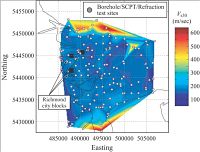Dr Katsu Goda studied the seismic loss estimation of buildings. Severe damage of structures due to infrequent and large earthquakes causes direct physical and financial distress to a great number of households and companies, and induces indirect ripple effects across regional and national economies (e.g. 2004 Sumatra, 2008 Sichuan, and 2010 Haiti earthquakes).
To make efficient and informed decisions for catastrophic earthquake risk mitigation, it is essential to develop a viable seismic loss estimation tool for multiple buildings.
The developed model can be used to tackle a wide range of problems, including life-cycle cost-benefit analysis of risk mitigation measures (e.g. seismic isolation), emergency preparedness planning, and earthquake insurance.
Case Study for Wood-frame Buildings in Vancouver, Canada
 Building inventory information of 1415 existing wood-frame houses in Vancouver was collected from the City of Richmond, British Columbia, Canada.
Building inventory information of 1415 existing wood-frame houses in Vancouver was collected from the City of Richmond, British Columbia, Canada.- Sensitivity analyses were carried out to identify key parameters for seismic loss estimation. Results indicate that impacts of seismic rates, ground motion prediction equations, and spatial correlations of seismic effects are significant.
- Moreover, the seismic loss model was applied to evaluate an insurer’s earthquake risk exposure.